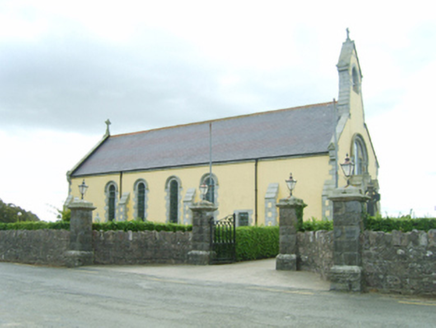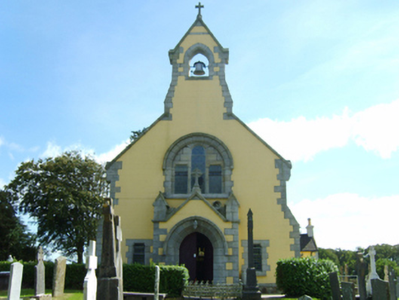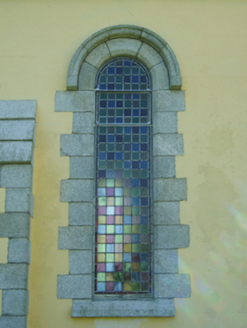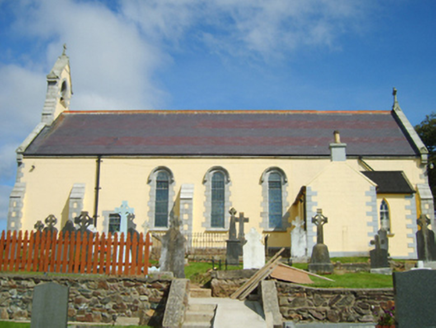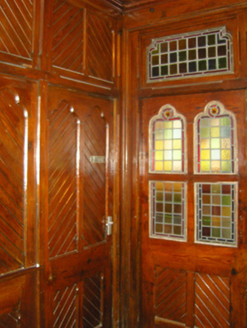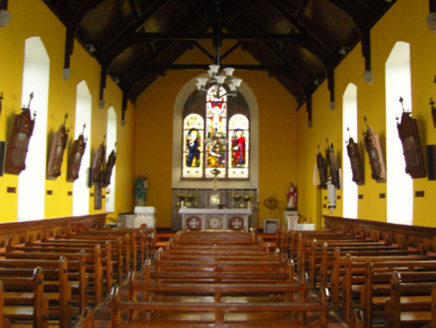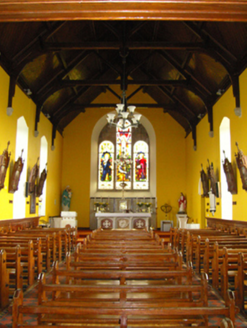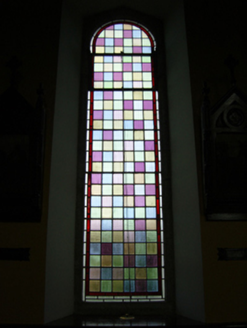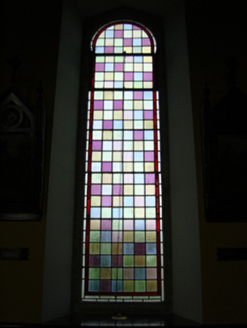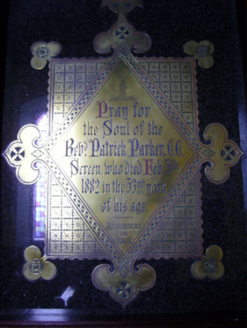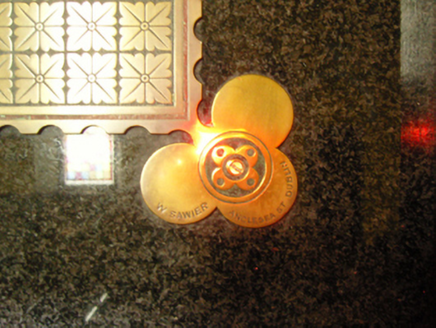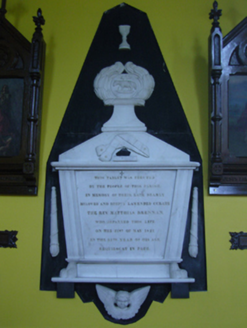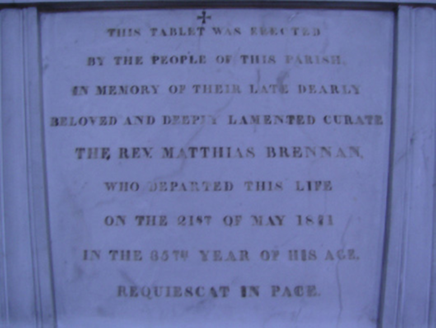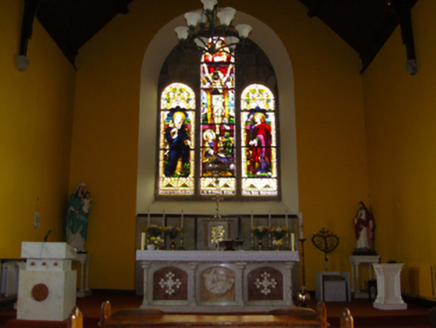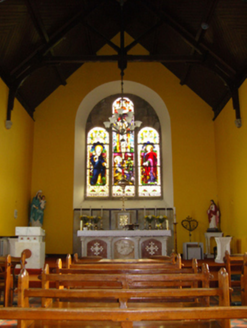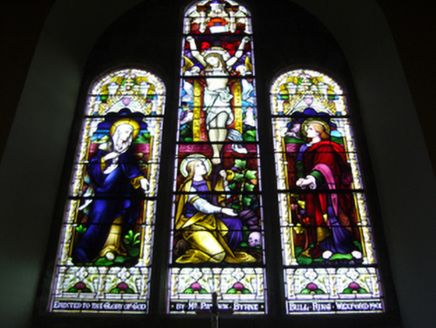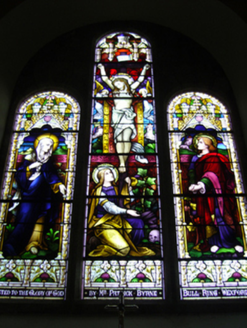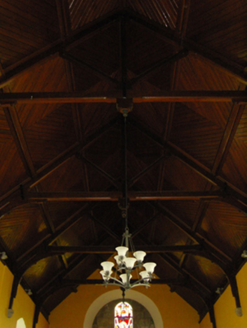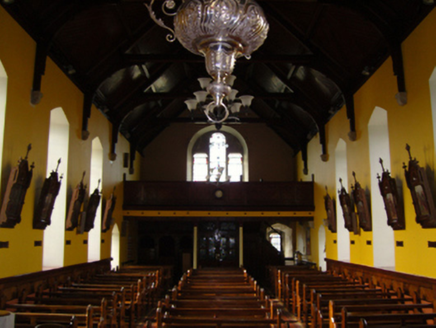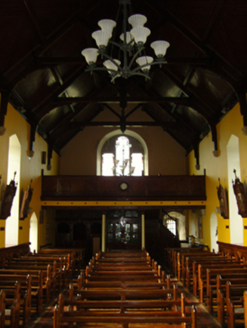Survey Data
Reg No
15703317
Rating
Regional
Categories of Special Interest
Architectural, Artistic, Historical, Social, Technical
Original Use
Church/chapel
In Use As
Church/chapel
Date
1900 - 1905
Coordinates
308312, 130023
Date Recorded
30/08/2007
Date Updated
--/--/--
Description
Detached seven-bay double-height single-cell Catholic Church, rebuilt 1901, on a rectangular plan. Renovated, ----, with sanctuary reordered. Pitched banded slate roof with perforated crested terracotta ridge tiles, cut-granite coping to gables on trefoil-detailed gabled corbel kneelers including cut-granite coping to gable to entrance (north) front on trefoil-detailed gabled corbel kneelers with buttressed gabled bellcote to apex framing cast-iron bell, and cast-iron rainwater goods on cut-granite eaves retaining cast-iron square profile downpipes. Rendered, ruled and lined walls on cut-granite chamfered cushion course on tuck pointed coursed or snecked rubble stone plinth with cut-granite buttresses including cut-granite buttresses to corners having cut-granite "slated" coping. Round-headed window openings with cut-granite sills, and cut-granite block-and-start surrounds having chamfered reveals with hood mouldings over on monolithic label stops framing storm glazing over fixed-pane fittings having stained glass margins centred on square glazing bars. Round-headed "Trinity Window" to chancel (south) in round-headed recess with cut-granite sill, and cut-granite block-and-start surround having chamfered reveals with hood moulding over on monolithic label stops framing storm glazing over fixed-pane fittings having leaded stained glass panels. Pointed-arch door opening to entrance (north) front, cut-granite surround having chamfered reveals with hood moulding over on monolithic label stops framing timber boarded double doors. "Trinity Window" to gable in round-headed recess with cut-granite sill, and cut-granite block-and-start surround having chamfered reveals with hood moulding over on monolithic label stops framing storm glazing over fixed-pane fittings having stained glass margins centred on square glazing bars. Interior including vestibule (north); square-headed door opening into nave with glazed timber panelled double doors having overlights; full-height interior open into roof with diagonal timber boarded or tongue-and-groove timber panelled choir gallery (north) on cast-iron pillars below frosted glass "Trinity Window", tessellated "quarry tile" aisles between timber pews, diagonal timber boarded or tongue-and-groove timber panelled wainscoting supporting carved timber dado rail, paired Gothic-style timber stations between frosted glass windows, polished brass wall monument (ob. 1882) with cut-white marble Classical-style wall monument (ob. 1871), carpeted stepped dais to sanctuary (south) reordered, ----, with cut-veined white marble panelled altar below stained glass memorial "Trinity Window" (1901), and exposed strutted collared timber roof construction on cut-granite beaded "Cavetto" corbels with wind braced diagonal timber boarded or tongue-and-groove timber panelled ceiling on carved timber cornice on perforated frieze. Set in landscaped grounds with drag edged rock faced limestone ashlar piers to perimeter having cut-granite "Cavetto" stringcourses below shallow pyramidal capping supporting wrought iron double gates.
Appraisal
A church erected to a design by Joseph Kelly Freeman (b. 1865) of Eccles Street, Dublin (Irish Builder 1901, 978), representing an integral component of the built heritage of County Wexford with the architectural value of the composition, one allegedly repurposing portions of a chapel marked on the first edition of the Ordnance Survey (surveyed 1840; published 1841), confirmed by such attributes as the compact rectilinear "barn" plan form, aligned along a liturgically-incorrect axis; the slender profile of the openings underpinning a streamlined Romanesque theme with the chancel defined by an elegant "Trinity Window"; and the handsome bellcote embellishing the roofline as a picturesque eye-catcher in the landscape. Having been well maintained, the elementary form and massing survive intact together with substantial quantities of the original fabric, both to the exterior and to the interior reordered (----) in accordance with the liturgical reforms sanctioned by the Second Ecumenical Council of the Vatican (1962-5) where contemporary joinery; reclaimed wall monuments commemorating Reverend Matthias Brennan CC (d. 1871) and Reverend Patrick Parker CC (d. 1882); and a vibrant "Trinity Window" donated (1901) 'by Mr. Patrick Byrne [of] Bull Ring Wexford', all highlight the artistic potential of the composition: meanwhile, an exposed timber roof construction pinpoints the engineering or technical dexterity of a church making a pleasing visual statement in a rural village street scene.
